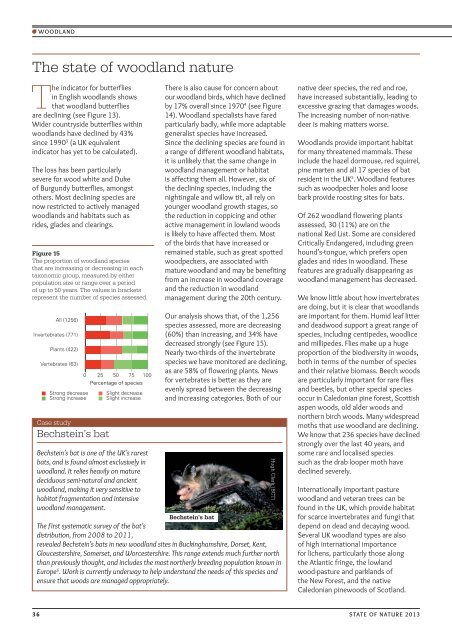State of Nature report - RSPB
State of Nature report - RSPB
State of Nature report - RSPB
You also want an ePaper? Increase the reach of your titles
YUMPU automatically turns print PDFs into web optimized ePapers that Google loves.
WOODLAND<br />
<br />
he indicator for butterflies<br />
in English woodlands shows<br />
that woodland butterflies<br />
are declining (see Figure 13).<br />
Wider countryside butterflies within<br />
woodlands have declined by 43%<br />
since 1990 3 (a UK equivalent<br />
indicator has yet to be calculated).<br />
The loss has been particularly<br />
severe for wood white and Duke<br />
<strong>of</strong> Burgundy butterflies, amongst<br />
others. Most declining species are<br />
now restricted to actively managed<br />
woodlands and habitats such as<br />
rides, glades and clearings.<br />
<br />
<br />
<br />
<br />
<br />
<br />
<br />
All (1256)<br />
Invertebrates (771)<br />
Plants (422)<br />
Vertebrates (63)<br />
Strong decrease<br />
Strong increase<br />
<br />
<br />
0 25 50 75 100<br />
Percentage <strong>of</strong> species<br />
Slight decrease<br />
Slight increase<br />
There is also cause for concern about<br />
our woodland birds, which have declined<br />
by 17% overall since 1970 4 (see Figure<br />
14). Woodland specialists have fared<br />
particularly badly, while more adaptable<br />
generalist species have increased.<br />
Since the declining species are found in<br />
a range <strong>of</strong> different woodland habitats,<br />
it is unlikely that the same change in<br />
woodland management or habitat<br />
is affecting them all. However, six <strong>of</strong><br />
the declining species, including the<br />
nightingale and willow tit, all rely on<br />
younger woodland growth stages, so<br />
the reduction in coppicing and other<br />
active management in lowland woods<br />
is likely to have affected them. Most<br />
<strong>of</strong> the birds that have increased or<br />
remained stable, such as great spotted<br />
woodpeckers, are associated with<br />
mature woodland and may be benefiting<br />
from an increase in woodland coverage<br />
and the reduction in woodland<br />
management during the 20th century.<br />
Our analysis shows that, <strong>of</strong> the 1,256<br />
species assessed, more are decreasing<br />
(60%) than increasing, and 34% have<br />
decreased strongly (see Figure 15).<br />
Nearly two-thirds <strong>of</strong> the invertebrate<br />
species we have monitored are declining,<br />
as are 58% <strong>of</strong> flowering plants. News<br />
for vertebrates is better as they are<br />
evenly spread between the decreasing<br />
and increasing categories. Both <strong>of</strong> our<br />
Bechstein’s bat is one <strong>of</strong> the UK’s rarest<br />
bats, and is found almost exclusively in<br />
woodland. It relies heavily on mature<br />
deciduous semi-natural and ancient<br />
woodland, making it very sensitive to<br />
habitat fragmentation and intensive<br />
woodland management.<br />
<br />
The first systematic survey <strong>of</strong> the bat’s<br />
distribution, from 2008 to 2011,<br />
revealed Bechstein’s bats in new woodland sites in Buckinghamshire, Dorset, Kent,<br />
Gloucestershire, Somerset, and Worcestershire. This range extends much further north<br />
than previously thought, and includes the most northerly breeding population known in<br />
Europe 6 . Work is currently underway to help understand the needs <strong>of</strong> this species and<br />
ensure that woods are managed appropriately.<br />
<br />
native deer species, the red and roe,<br />
have increased substantially, leading to<br />
excessive grazing that damages woods.<br />
The increasing number <strong>of</strong> non-native<br />
deer is making matters worse.<br />
Woodlands provide important habitat<br />
for many threatened mammals. These<br />
include the hazel dormouse, red squirrel,<br />
pine marten and all 17 species <strong>of</strong> bat<br />
resident in the UK 5 . Woodland features<br />
such as woodpecker holes and loose<br />
bark provide roosting sites for bats.<br />
Of 262 woodland flowering plants<br />
assessed, 30 (11%) are on the<br />
national Red List. Some are considered<br />
Critically Endangered, including green<br />
hound’s-tongue, which prefers open<br />
glades and rides in woodland. These<br />
features are gradually disappearing as<br />
woodland management has decreased.<br />
We know little about how invertebrates<br />
are doing, but it is clear that woodlands<br />
are important for them. Humid leaf litter<br />
and deadwood support a great range <strong>of</strong><br />
species, including centipedes, woodlice<br />
and millipedes. Flies make up a huge<br />
proportion <strong>of</strong> the biodiversity in woods,<br />
both in terms <strong>of</strong> the number <strong>of</strong> species<br />
and their relative biomass. Beech woods<br />
are particularly important for rare flies<br />
and beetles, but other special species<br />
occur in Caledonian pine forest, Scottish<br />
aspen woods, old alder woods and<br />
northern birch woods. Many widespread<br />
moths that use woodland are declining.<br />
We know that 236 species have declined<br />
strongly over the last 40 years, and<br />
some rare and localised species<br />
such as the drab looper moth have<br />
declined severely.<br />
Internationally important pasture<br />
woodland and veteran trees can be<br />
found in the UK, which provide habitat<br />
for scarce invertebrates and fungi that<br />
depend on dead and decaying wood.<br />
Several UK woodland types are also<br />
<strong>of</strong> high international importance<br />
for lichens, particularly those along<br />
the Atlantic fringe, the lowland<br />
wood-pasture and parklands <strong>of</strong><br />
the New Forest, and the native<br />
Caledonian pinewoods <strong>of</strong> Scotland.<br />
36 STATE OF NATURE 2013

















